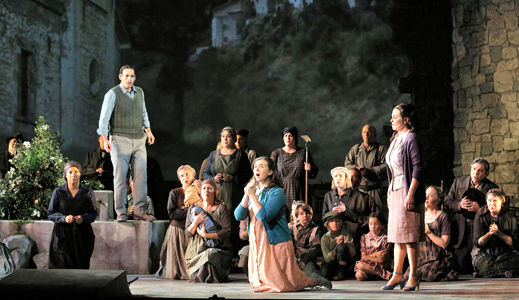
SAN FRANCISCO – The world premiere production of a new opera based on a 1958 novel by Alberto Moravia, which Vittorio De Sica adapted to film in 1960 as Two Women, starring Sophia Loren, has struck musical gold. A co-commission between San Francisco Opera and the Teatro Regio di Torino, the city of Turin’s opera house, Two Women received five performances in June (seen June 23) at the War Memorial Opera House. The whole production will be packed up and sent to Turin in preparation for its 2018 European premiere.
Italian composer Marco Tutino’s Two Women is a throwback in many different ways. In the first place, it marks the first Italian-language opera to be commissioned in the U.S. since Giacomo Puccini’s La fanciulla del West (The Girl of the Golden West) debuted at the Metropolitan Opera in 1910. Secondly, Tutino is stylistically lyrical and accessible, though not eschewing the full range of modernistic colors available to him. Listening to his opera (his 15th, by the way), one can imagine that this is what a Puccini of today might be writing – musically expert and sophisticated, while also aiming (heaven forbid!) for popularity and acceptance.
And third, his subject matter looks back to a well known film, and the novel behind that by a major Italian writer, and the troubling period of 1943-45, when Italy went from fascist state and Axis ally under Benito Mussolini to wartime battleground involving Italian, German, American, and French Moroccan forces, all contending to gain the upper hand.
With its gritty, often grim and morally compromised setting, Two Women is the latest installment in musical theater neorealism, itself a descendant of the verismo movement in opera best represented by such works as I pagliacci and Cavalleria rusticana. I was reminded that at a certain time in American musical history, such conservatory-trained composers as Kurt Weill, Leonard Bernstein, Marc Blitzstein, Virgil Thomson, Gian Carlo Menotti, and others in the more popular tradition such as Richard Rodgers, Jerome Kern, and Stephen Sondheim, saw their works premiered on Broadway, works that are now more often seen in the opera house. There is no sin in telling an effective good story and inviting your audience to appreciate it.
Part of what makes the opera work so well is the masterful source material. Novelist Alberto Moravia (1907-1990) lived through the Mussolini period, got into regular trouble with the censors, and fled with other refugees to the rural area east of Rome called La Ciociaria as World War II wound down. That time led to the novel La ciociara (The Woman of La Ciociaria). Although Moravia believed that the writer must “assume a moral position, a clearly conceived political, social, and philosophical attitude,” he did not subscribe to the constricting tenets of socialist realism. He was drawn to explore the murky ambiguities of the human soul under stress.
Between 1959 and 1962 Moravia was president of the worldwide association of writers, PEN International. Later, in the years 1984-89, Moravia represented the Italian Communist Party as a member of the European Parliament. Moravia is also well known for Bernardo Bertolucci’s film adaptation of his novel about the fascist era, The Conformist.
Two film montages, comprised of contemporary newsreel footage and each about five minutes long, precede acts I and II of the opera, helpfully providing a clear time frame for the action, which takes place in Rome, the town of Fondi, and the smaller rural community of refugees, Sant’Eufemia. They trace the movements of troops and the swiftly changing political situation on the ground. The melodic, neo-Romantic score is punctuated frequently, and appropriately, by gunshots, bombs and explosions. Tutino incorporates regional folk and popular songs into the libretto, which he wrote with Fabio Ceresa, adapted from a script by Luca Rossi.
Characters in Two Women include the mother, Cesira (the Loren role), given a knockout performance by one of today’s operatic superstars, the sensuous dramatic soprano Anna Caterina Antonacci. Also, her daughter Rosetta (Sarah Shafer), a 16-year-old who does a whole lot of growing up in two and a half hours, becoming by the end the second of the “two women.” Michele, a high tenor, is a passionately committed young partisan (a communist, no doubt), portrayed superbly by the rising American Dimitri Pittas in his SFO debut. The other major character is Giovanni, sung by the world-renowned baritone Mark Delavan; in this role the creators conflate all of society’s opportunism and cynicism as heightened during a war with shifting forces in control every few weeks or months. Other smaller roles are handled with perfect direction (by Francesca Zambello). And the chorus of townspeople and villagers plays a huge role, masterfully led by Ian Robertson. SFO Music Director Nicola Luisotti conducted.
The individual characters, as well as the general populace, are put to excruciating tests, and few are wholly pure or evil. But with the Allied victory there is hope for a better future, showing that little in the human character is truly independent of objective circumstance. Social conditions do impact action and behavior, even as the essential human nature is subject to a wide range of moral response.
In sum, an unqualified triumph. I wish these Two Women a long, happy life!
The final performance of Two Women is scheduled for Tuesday, June 30 at 7:30 pm at the opera house at 301 Van Ness Ave. (at Grove St.), San Francisco. For tickets and further information, go to sfopera.com, or call (415) 864.3330. Standing Room tickets for $10 cash only go on sale at 10 am on the day of the performance.
Photo: Prayer Scene with Chorus
Dimitri Pittas as Michele, Sarah Shafer as Rosetta, Anna Caterina Antonacci as Cesira. ©Cory Weaver/San Francisco Opera










